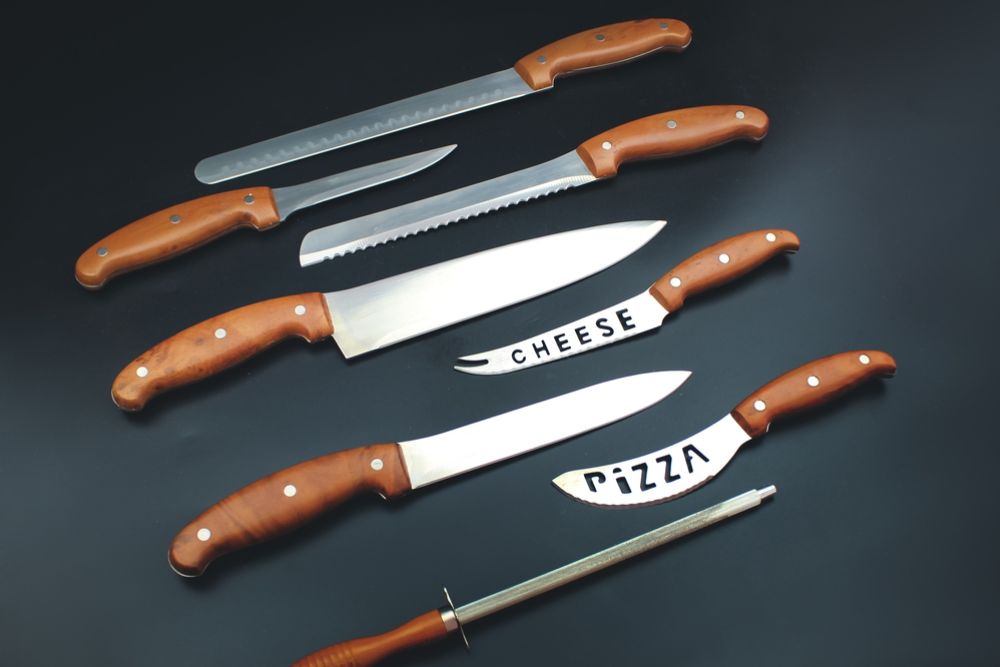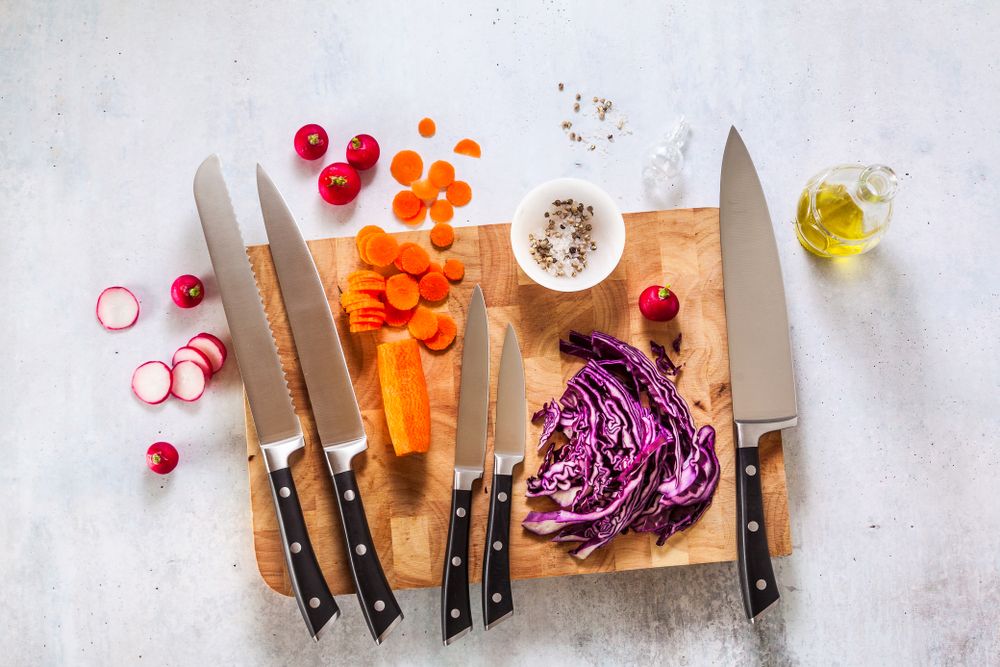Knives are the backbone of any kitchen, affecting everything from meal preparation speed to food presentation. Yet with countless options available—various materials, brands, and pricing tiers—picking the right knife set can feel daunting. A well-chosen knife set should not only be sharp and well-balanced but also suit your cooking style and deliver years of reliable service. This guide walks you through the essential factors to consider, from blade construction to handle ergonomics, ensuring that your new knife set becomes a trusted partner in every culinary endeavor.
1. Why Invest in a Quality Knife Set?
Why It Matters
Using dull or poorly made knives can slow down your prep work, increase the risk of accidents, and lead to inconsistent results. In contrast, a high-quality knife set offers precision and efficiency, allowing you to tackle everything from delicate slicing to rugged chopping with ease.
Benefits of a Good Knife Set
- Time Savings: Sharp, well-designed knives make cutting tasks faster and smoother.
- Consistency and Control: Accurately slice vegetables, meats, and more, improving your final dish’s texture and presentation.
- Durability: Quality blades can last for years—possibly decades—with proper care, outlasting cheaper, lower-grade knives.
- Safety: A sharp blade is actually safer, requiring less force and reducing the likelihood of slipping.
Takeaway: Rather than juggling a mismatched collection of subpar knives, investing in a well-curated set can streamline cooking, boost enjoyment, and elevate your culinary results.
2. Know Your Essential Knives
Why It Matters
Some knife sets come packed with a dozen different blades, but not all are necessary for home cooks. Before buying, know which knives you truly need so you’re not paying for extras that will gather dust.
Key Knives
- Chef’s Knife (8–10 inches)
- Role: The workhorse, handling 70–80% of tasks—chopping, slicing, dicing, and mincing.
- Features: A curved belly for rocking motions, a sturdy spine for heavier cuts, and enough length to handle big items like melon or large vegetables.
- Paring Knife (3–4 inches)
- Role: Ideal for precision tasks—peeling, trimming, and delicate cutting.
- Features: Small, nimble blade that you can maneuver with fine control.
- Serrated Bread Knife (8–10 inches)
- Role: Excellent for cutting through crusty bread, tomatoes, or other foods with a firm exterior and soft interior.
- Features: Saw-like scallops that grip without squashing or tearing delicate surfaces.
Nice-to-Have Extras
- Utility Knife (5–6 inches): A middle ground for tasks too small for a chef’s knife but too large for a paring knife.
- Boning/Fillet Knife: Thin, flexible blade for removing bones or skinning fish.
- Santoku Knife: A Japanese all-purpose knife, typically shorter and with a flatter edge than a chef’s knife.
- Carving/ slicing Knife: For slicing roasts or poultry into neat, uniform cuts.
Takeaway: Aim for at least a chef’s knife, paring knife, and serrated knife in any set you buy. Additional specialty knives are handy but may not be essentials for every cook.
3. Blade Materials and Construction
Why It Matters
Knives are primarily made from stainless steel or high-carbon steel, but specific alloys and manufacturing methods can drastically affect sharpness, durability, and maintenance requirements. Understanding the basics helps you choose a set that aligns with your preferences and upkeep tolerance.
Common Blade Materials
- Stainless Steel
- Pros: Resists rust and stains, relatively easy to maintain.
- Cons: Might not hold an edge quite as long as high-carbon steel (though modern stainless steels can still be very sharp and long-lasting).
- High-Carbon Stainless Steel
- Pros: Combines the edge retention and strength of carbon steel with stainless’s corrosion resistance. A popular choice for quality knives.
- Cons: Usually pricier.
- Carbon Steel (Less common in mass-market sets, used by some specialty makers)
- Pros: Superb edge retention, can be extremely sharp.
- Cons: Rusts more easily, requires careful drying and maintenance.
Construction Methods
- Forged Blades
- Process: A single piece of steel is heated and hammered into shape, often resulting in a bolster (the thick area between handle and blade).
- Pros: Generally stronger, better edge retention, more balanced feel.
- Cons: Usually cost more due to labor-intensive manufacturing.
- Stamped Blades
- Process: Stamped from a sheet of steel, then sharpened and finished.
- Pros: Lighter, often more affordable.
- Cons: May require more frequent sharpening, can be less balanced or durable.
Takeaway: If budget allows, forged high-carbon stainless steel knives often hit the sweet spot of durability, ease of maintenance, and performance. Stamped knives can still be good if carefully selected from a reputable brand.
4. Handle Ergonomics and Comfort
Why It Matters
Your hand and the knife’s handle must work in harmony. Uncomfortable or slippery handles can lead to fatigue or even accidents, especially during lengthy prep sessions. Comfort is highly subjective, so testing or reading user feedback is key.
Common Handle Materials
- Wood: Traditional and warm, though may require extra care to avoid warping or bacterial buildup. Look for stabilized or resin-infused wood for better durability.
- Plastic/Polymer: Resistant to moisture, easy to clean, often used in commercial or dishwasher-safe knives.
- Micarta/G10: Composite materials known for high durability, water resistance, and a secure grip.
- Metal/Stainless: Sleek, modern look but can be slippery if poorly designed or lacking texture.
Ergonomics
- Bolster: A bolster (on forged knives) can add balance but also weight. Some prefer a partial or no bolster for easier cutting techniques.
- Handle Shape: Curved or contoured handles might support a more natural grip.
- Balance Point: Generally near the junction of the blade and handle. A well-balanced knife feels neither blade-heavy nor handle-heavy.
Takeaway: Seek a comfortable, slip-resistant handle material. If possible, hold the knife in-store or read detailed reviews to gauge how it feels in actual use.

5. Sets vs. Individual Knives
Why It Matters
Buying a full set can be convenient—matching handles, uniform brand—but you risk paying for knives you don’t use. Alternatively, building your own set (purchasing each knife individually) lets you tailor your collection.
Pros of Buying a Set
- Cost Savings: Often cheaper than purchasing each knife separately.
- Aesthetic Cohesion: Matching knives can look sleek in a block or on a magnetic strip.
- One-Time Decision: Less time spent sourcing multiple individual knives.
Pros of Buying Individual Knives
- Customization: Handpick your favorite brand or style for each type of knife.
- Higher Quality on Core Knives: Focus budget on the knives you’ll use most (chef’s, paring, serrated) rather than on rarely used specialty blades.
- Easier Upgrades: You can upgrade or replace knives piece-by-piece if preferences change or budget grows.
Takeaway: If you want quick, uniform solutions, a set is convenient. Enthusiastic home cooks may prefer curating each knife carefully for maximum quality and personal preference.
6. Maintenance and Care
Why It Matters
Even top-tier knives dull over time and can develop corrosion if neglected. Proper care preserves their longevity and performance.
Must-Do Steps
- Hand Washing: Dishwashers can damage blades and handles, so gently hand wash with mild soap and dry immediately.
- Proper Storage: Use a knife block, magnetic strip, or blade guards—never toss them loose in a drawer.
- Regular Honing: A few quick strokes on a honing steel helps keep the edge aligned between sharpenings.
- Professional Sharpening: Depending on usage, get knives sharpened every 6–12 months, or use a quality whetstone if you’re adept at manual sharpening.
Takeaway: High-quality knives demand mindful handling—avoid the dishwasher, store them safely, and maintain their edges. Neglecting these steps can degrade even the finest blades.
7. Balancing Budget and Quality
Why It Matters
Knife sets can range from under $50 to well over $1,000. Your investment should match both your cooking habits and financial comfort. Splurging on top-tier brands might not be necessary if you’re only cooking occasionally.
Price Tiers
- Budget ($50–$150): Basic stamped sets; decent for casual home cooks. Expect to replace or sharpen often.
- Mid-Range ($150–$300): Good quality forged or high-end stamped knives, often from reputable brands. Ideal for most cooking enthusiasts.
- Premium ($300+): Top-notch steel, handcrafted finishes, and exceptional balance. Great for serious home cooks or professionals.
Takeaway: Identify how frequently and intensely you’ll use your knives. A well-chosen mid-range set often satisfies the average home cook’s needs, while advanced hobbyists or professionals may appreciate the craftsmanship of premium brands.
A high-quality knife set is among the most valuable investments any cooking enthusiast can make. The right set will streamline tasks from chopping onions to filleting fish, offering the precision and comfort to tackle any recipe. Begin by prioritizing essential knives—a chef’s knife, paring knife, and serrated bread knife—then expand with specialty blades if desired. Look for durable, well-constructed blades (forged high-carbon stainless steel is a standout choice) paired with comfortable handles that suit your grip.
Consider how you’ll maintain and store your knives—regular honing, handwashing, and proper storage can prolong their lifespan significantly. Whether you opt for a cohesive set or assemble knives individually, focus on top-notch pieces that match your budget and cooking style, ensuring your new tools become trusted companions rather than clutter. With these guidelines in mind, you’ll be well on your way to enjoying the ease, speed, and satisfaction that come from wielding a truly superior knife set in your kitchen.





